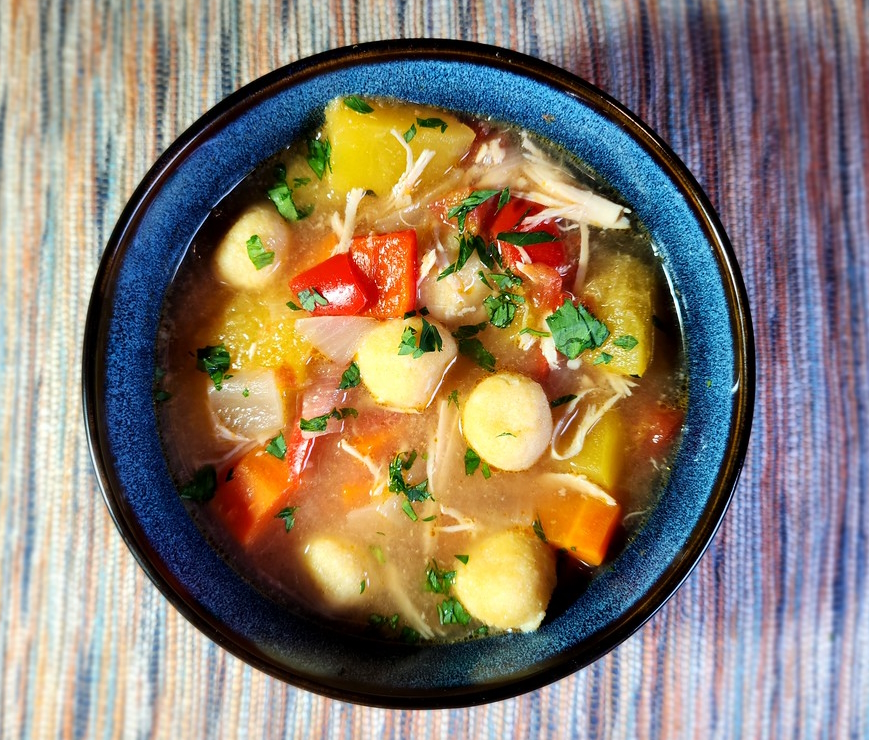This month’s recipe is Fijian Kokoda (pronounced "ko-konda"), a simple yet flavorful dish made with fresh fish, crisp vegetables, lime juice, and creamy coconut milk. As the weather here turns a bit colder and wetter, we can take a bite of Kokoda, close our eyes, and daydream about relaxing on a sun-soaked beach in tropical Fiji! Kokoda can be eaten as a snack, appetizer, or main course. Kokoda is a popular dish for celebratory events and special occasions.

Fiji, an archipelago of over 300 islands in the South Pacific, has a rich cultural history influenced by indigenous Fijian traditions and Indian, Chinese, and European colonial influences. Much of the food eaten in Fiji is delightfully influenced by Indian cuisine. But since we have featured many dishes that are South Asian, we looked for a recipe that might be more indigenously Fijian, and Kokoda fits the bill! It is considered to be the national dish of Fiji.
The indigenous people in Fiji, known as iTaukei, compose the majority of the Fijian populace. Fijian culture is richly communal, and Fijian villages are organized around clans and a chiefdom social structure. Oral traditions including storytelling are a vibrant part of Fijian life. English and Fijian are the official languages. Pottery, weaving, and wood carving, popular with visiting tourists are also imbued with cultural and spiritual symbols and meaning. Performances of "Meke", a blend of dance and storytelling, convey meanings that evoke iTaukei history, mythology, and daily life.
As in most cultures, in Fiji, food plays a central role society. Eating in Fiji is a highly social activity, a time for friends and family to gather and prepare food together. Fijian communal meals are often accompanied by storytelling or a type of inclusive participatory discussion known generally as "Talanoa". Storytelling may happen during the preparation of communal meals or during their consumption.
Kokoda can be made from a variety of firm white fish, snapper, waloo, mahi-mahi, swai, or cod. The fish is "cooked" in lime juice. Cooking fish in acids such as vinegar or citrus juices denatures the proteins in the fish, similar to cooking with heat (but see below).
Cultural Note: The reason that so many Fijians are of South Asian descent is that Fiji was part of the British colonial empire. Slavery was abolished in 1834 in the United Kingdom and its possessions. It was replaced by an officially sanctioned system of indentured servitude. Approximately 1.5 million indentured laborers were transported to British colonies between 1834 and 1920, with the majority (around 85%) coming from India. Terms of servitude were typically 5 years, but the working conditions and brutality by plantation owners was often beyond horrible. Most indentured laborers were lured into service with false promises of a better life, good pay, and return passage to India once their contract expired. Due to the enormity of the abuses, the practice was outlawed in 1920. Today, nearly 40% of Fijians are of Indian descent.
Kokoda is often served in coconut shells, which adds some authentic feel. It occurs to me that if you can obtain young coconuts, the soft coconut adhering to the inside of the shell would be an absolutely delicious complement to Kokoda. Unfortunately, most coconuts found here in San Diego are mature coconuts in which the "meat" is hard. If you can't find whole husked coconuts in your local market, they are usually available at Specialty Produce.
Note on Food Safety: Most recipes for sushi, ceviche, and Kokoda itself suggest using "fresh fish" or "parasite-free" fish. However, unless you live in a fishing village in Fiji and are a board-certified pathologist, this is probably not good or helpful advice. In America, fish that is presumed to be "fresh" is nearly always thawed frozen fish. Most ocean fish is frozen on the fishing boat before it ever reaches the shore. Freezing fish, either to very cold temperatures or for a long time kills most parasites. "Cooking" food in acid inhibits the growth of pathogens, but it does not kill them like actual cooking employing heat does. The head chef of the acclaimed sushi chef, Shin Tsujimura, at the Nobu restaurant in New York City, claims that he cannot taste the difference between thawed and fresh fish. The "fresh" fish you see in supermarkets is nearly always thawed previously frozen fish. The FDA Food Code (3-402.11-12) requires that fish that is served raw or under-cooked be frozen for the destruction of parasites, with the exceptions of large tuna, fish eggs, farm-raised fish, and some types of shellfish. Sushi and ceviches (like Kokoda) are the main culprits in seafood-borne illnesses. So take care!
Ingredients:
- 1 pound fresh white fish (e.g., snapper, mahi-mahi, or cod), diced in 1/2 inch pieces
- 1 cup fresh lime juice (for marinating)
- 1 cup coconut cream or coconut milk
- 1/4 cup shallots, scallions, or sweet onion, very finely diced
- 1 to 3 small red chilies, finely sliced
- 1 medium tomato diced or 1/2 cup of quartered cherry tomatoes
- 1/2 red bell pepper, diced
- 1/2 yellow pepper, diced
- 1/2 cup diced cucumber
- ½ cup chopped cilantro
- Salt and pepper to taste
Preparation:
- Dice the fish (it's easier if it is only halfway thawed).
- Put fish in a non-reactive bowl and cover with lime juice. Ensure all pieces are submerged.
- Cover and refrigerate for 4-6 hours until the fish turns opaque.
- After the fish is finished "cooking", prepare all the vegetables.
- Drain most of the liquid from the fish and mix in the vegetables, chilies, and cilantro.
- Mix in the coconut cream/milk.
Eating Kokoda with a bowl of warm Jasmine rice is delicious!
Recipe and photos by T. Johnston-O'Neill








